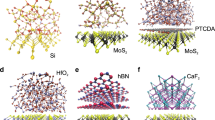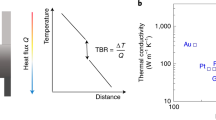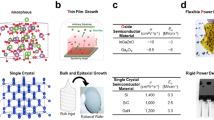Abstract
Decrease in processing speed due to increased resistance and capacitance delay is a major obstacle for the down-scaling of electronics1,2,3. Minimizing the dimensions of interconnects (metal wires that connect different electronic components on a chip) is crucial for the miniaturization of devices. Interconnects are isolated from each other by non-conducting (dielectric) layers. So far, research has mostly focused on decreasing the resistance of scaled interconnects because integration of dielectrics using low-temperature deposition processes compatible with complementary metal–oxide–semiconductors is technically challenging. Interconnect isolation materials must have low relative dielectric constants (κ values), serve as diffusion barriers against the migration of metal into semiconductors, and be thermally, chemically and mechanically stable. Specifically, the International Roadmap for Devices and Systems recommends4 the development of dielectrics with κ values of less than 2 by 2028. Existing low-κ materials (such as silicon oxide derivatives, organic compounds and aerogels) have κ values greater than 2 and poor thermo-mechanical properties5. Here we report three-nanometre-thick amorphous boron nitride films with ultralow κ values of 1.78 and 1.16 (close to that of air, κ = 1) at operation frequencies of 100 kilohertz and 1 megahertz, respectively. The films are mechanically and electrically robust, with a breakdown strength of 7.3 megavolts per centimetre, which exceeds requirements. Cross-sectional imaging reveals that amorphous boron nitride prevents the diffusion of cobalt atoms into silicon under very harsh conditions, in contrast to reference barriers. Our results demonstrate that amorphous boron nitride has excellent low-κ dielectric characteristics for high-performance electronics.
This is a preview of subscription content, access via your institution
Access options
Access Nature and 54 other Nature Portfolio journals
Get Nature+, our best-value online-access subscription
$29.99 / 30 days
cancel any time
Subscribe to this journal
Receive 51 print issues and online access
$199.00 per year
only $3.90 per issue
Buy this article
- Purchase on SpringerLink
- Instant access to full article PDF
Prices may be subject to local taxes which are calculated during checkout



Similar content being viewed by others
Data availability
The datasets generated and/or analysed during the current study are available from the corresponding authors on reasonable request.
Code availability
The code used to generate the figures is available from the corresponding authors on reasonable request.
References
Shamiryan, D., Abell, T., Iacopi, F. & Maex, K. Low-k dielectric materials. Mater. Today 7, 34–39 (2004).
Moore’s deviation. Nat. Nanotechnol. 12, 1105 (2017).
Akinwande, D. et al. Graphene and two-dimensional materials for silicon technology. Nature 573, 507–518 (2019).
IRTS. More Moore roadmap in The International Technology Roadmap for Semiconductors 2.0 White Paper: 2015 15–16 (IEEE, 2015); http://itrs2.net.
King, S. W. Dielectric barrier, etch stop, and metal capping materials for state of the art and beyond metal interconnects. ECS J. Solid State Sci. Technol. 4, N3047 (2015).
del Alamo, J. A. Nanometre-scale electronics with III–V compound semiconductors. Nature 479, 317–323 (2011).
Venema, L. Silicon electronics and beyond. Nature 479, 309 (2011).
Franklin, A. D. Nanomaterials in transistors: from high-performance to thin-film applications. Science 349, aab2750 (2015).
Koenderink, A. F., Alù, A. & Polman, A. Nanophotonics: shrinking light-based technology. Science 348, 516–521 (2015).
Liu, C. et al. Small footprint transistor architecture for photoswitching logic and in situ memory. Nat. Nanotechnol. 14, 662–667 (2019).
Xiang, D., Liu, T. & Chen, W. Fused computing and storage in a 2D transistor. Nat. Nanotechnol. 14, 642–643 (2019).
Grill, A. PECVD low and ultralow dielectric constant materials: from invention and research to products. J. Vac. Sci. Technol. B 34, 020801 (2016).
IRDS. More Moore in The International Roadmap for Devices and Systems: 2017, (IEEE, 2017); http://irds.ieee.org.
IRTS. Interconnect in The International Technology Roadmap for Semiconductors 2.0: 2015 (2015); http://itrs2.net.
Liu, J. et al. Plasma deposition of low dielectric constant (k = 2.2~2.4) boron nitride on methylsilsesquioxane-based nanoporous films. J. Appl. Phys. 96, 6679–6684 (2004).
Glavin, N. R. et al. Amorphous boron nitride: a universal, ultrathin dielectric for 2D nanoelectronics. Adv. Funct. Mater. 26, 2640–2647 (2016).
Kim, G. et al. Growth of high-crystalline, single-layer hexagonal boron nitride on recyclable platinum foil. Nano Lett. 13, 1834–1839 (2013).
Jang, A. R. et al. Wafer-scale and wrinkle-free epitaxial growth of single-orientated multilayer hexagonal boron nitride on sapphire. Nano Lett. 16, 3360–3366 (2016).
Plass, M. F., Fukarek, W., Mändl, S. & Möller, W. Phase identification of boron nitride thin films by polarized infrared reflection spectroscopy. Appl. Phys. Lett. 69, 46–48 (1996).
Kim, D. Y. et al. Role of hydrogen carrier gas on the growth of few layer hexagonal boron nitrides by metal-organic chemical vapor deposition. AIP Adv. 7, 045116 (2017).
Jiménez, I. et al. Core-level photoabsorption study of defects and metastable bonding configurations in boron nitride. Phys. Rev. B 55, 12025–12037 (1997).
Dharma-wardana, M. W. C. Relation of the refractive index to the dielectric constant containing Doppler-like spatial dispersion. J. Phys. Math. Gen. 9, L93–L97 (1976).
Ling, X. & Zhang, J. Interference phenomenon in graphene-enhanced Raman scattering. J. Phys. Chem. C 115, 2835–2840 (2011).
Plimpton, S., Crozier, P. & Thompson, A. LAMMPS-Large-Scale Atomic/Molecular Massively Parallel Simulator (Sandia National Laboratories, 2007).
Los, J. et al. Extended Tersoff potential for boron nitride: energetics and elastic properties of pristine and defective h-BN. Phys. Rev. B 96, 184108 (2017).
Tersoff, J. Empirical interatomic potential for silicon with improved elastic properties. Phys. Rev. B 38, 9902 (1988).
Matsunaga, K. & Iwamoto, Y. Molecular dynamics study of atomic structure and diffusion behavior in amorphous silicon nitride containing boron. J. Am. Ceram. Soc. 84, 2213–2219 (2001).
Al-Ghalith, J., Dasmahapatra, A., Kroll, P., Meletis, E. & Dumitricǎ, T. Compositional and structural atomistic study of amorphous Si–B–N networks of interest for high-performance coatings. J. Phys. Chem. C 120, 24346–24353 (2016).
Kimura, K., Joumori, S., Oota, Y., Nakajima, K. & Suzuki, M. High-resolution RBS: a powerful tool for atomic level characterization. Nucl. Instrum. Methods Phys. Res. B 219-220, 351–357 (2004).
Kitahara, A., Yasuno, S. & Fujikawa, K. Study of thin-film thickness and density by high-resolution Rutherford backscattering spectrometry and X-ray reflectivity. Trans. Mater. Res. Soc. Jpn. 34, 613–615 (2009).
Hatton, B. D. et al. Materials chemistry for low-k materials. Mater. Today 9, 22–31 (2006).
Cheng, Y.-L. & Lee, C.-Y. in Nanoporous Materials Porous Low-Dielectric-Constant Material for Semiconductor Microelectronics Ch. 6 (IntechOpen, 2018).
Zhao, L. et al. Role of copper in time dependent dielectric breakdown of porous organo-silicate glass low-k materials. Appl. Phys. Lett. 99, 222110 (2011).
Volinsky, A. A., Palacio, M. L. B. & Gerberich, W. W. "Incompressible" pore effect on the mechanical behavior of low-K dielectric films. In MRS Proceedings Vol. 750, 567–572 (2002).
Das, A. et al. Characterisation and integration feasibility of JSR’s low-k dielectric LKD-5109. Microelectron. Eng. 64, 25–33 (2002).
Chang, S. Y. et al. Mechanical property analyses of porous low-dielectric-constant films for stability evaluation of multilevel-interconnect structures. Thin Solid Films 460, 167–174 (2004).
Li, H. Y. et al. Process improvement of 0.13 μm Cu/Low K (Black DiamondTM) dual damascene interconnection. Microelectron. Reliab. 45, 1134–1143 (2005).
Pang. B., Yau W., Lee P. & Naik M. A New CVD Process for Damascene Low-k Applications 285–289 (Semiconductor Fabtech, 1999).
Sekhar, N. V. in Nanoindentation in Materials Science (ed. Němeček, J.) Ch. 10 (InTech, 2012).
Tyberg, C. et al. in Polymers for Microelectronics and Nanoelectronics Vol. 874, 161–172 (American Chemical Society, 2004).
Im, J., Townsend, P. H., Curphy, J., Karas, C. & Shaffer, E. O. in Metallization of Polymers 2 (ed Sacher, E.) 53–60 (Springer, 2002).
Grill, A. Plasma enhanced chemical vapor deposited SiCOH dielectrics: from low-k to extreme low-k interconnect materials. J. Appl. Phys. 93, 1785–1790 (2003).
Brandrup, J., Immergut, E. H. & Grulke, E. A. Polymer Handbook 4th edn (Wiley-Interscience, 2004).
Lee, H. J. et al. Structural characterization of porous low-k thin films prepared by different techniques using X-ray porosimetry. J. Appl. Phys. 95, 2355–2359 (2004).
Laturia, A., Van de Put, M. L. & Vandenberghe, W. G. Dielectric properties of hexagonal boron nitride and transition metal dichalcogenides: from monolayer to bulk. npj 2D Mater. Appl. 2, 6 (2018).
Acknowledgements
We thank UNIST Central Research Facilities (UCRF) and Y. K. Kim for the cross-sectional high-resolution TEM images. This work was supported by Samsung Electronics (Samsung-SKKU Graphene/2D Center), the research fund (NRF-2017R1E1A1A01074493 and NRF-2019R1A4A1027934), the IBS (IBS-R-019-D1) and a grant (CASE-2013M3A6A5073173) from the Centre for Advanced Soft Electronics under the Global Frontier Research Program via the National Research Foundation of the Ministry of Science and ICT, South Korea. The NEXAFS experiments performed at the 4D, 6D and 10A2 beamlines of the Pohang Accelerator Laboratory (PAL) were supported in part by the Ministry of Science and ICT, POSTECH and UNIST. M.C. acknowledges support from Leverhulme Trust Research Grant RPG-2019-227. S.R., A.A. and M.C. acknowledge the European Union Horizon 2020 research and innovation programme for grant number 785219 and 881603 (Graphene Flagship). A.A. is supported by Project MECHANIC (PCI2018-093120) funded by Ministerio de Ciencia, Innovación y Universidades. The Catalan Institute of Nanoscience and Nanotechnology is funded by the CERCA Programme/Generalitat de Catalunya and supported by the Severo Ochoa Centres of Excellence programme, funded by the Spanish Research Agency (grant number SEV-2017-0706).
Author information
Authors and Affiliations
Contributions
H.S.S. and H.-J.S. planned and supervised this project. S.H., K.Y.M., G.K, S.I.Y. and H.S.S. performed the growth and characterization experiments. C.-S.L., M.-H.L. and H.-J.S. fabricated the electrical devices. S.W.K. performed and analysed the ellipsometry measurements. H.-I.L. obtained and analysed the RBS data. Y.L. and Z.L. obtained the TEM data. K.I., K.-J.K. and T.J.S. measured the NEXAFS data. E.-c.J., H.J. and J.-Y.K measured the mechanical properties and adhesion. A.A. and S.R. performed the molecular dynamics simulations. M.C. suggested key experiments and measurements and helped with the interpretation of results. M.C. wrote and edited the manuscript with H.S.S. All authors contributed to the writing of the manuscript and agreed on the contents of the paper.
Corresponding authors
Ethics declarations
Competing interests
The authors declare no competing interests.
Additional information
Peer review information Nature thanks Francesca Iacopi, Lain-Jong Li and Junhao Lin for their contribution to the peer review of this work.
Publisher’s note Springer Nature remains neutral with regard to jurisdictional claims in published maps and institutional affiliations.
Extended data figures and tables
Extended Data Fig. 1 Growth of a-BN on Cu and SiO2 substrates.
a–c, Raman (a), XPS (b) and EDS mapping (c) images of a-BN grown on copper foils (plasma power 30 W, growth temperature 300 °C) and transferred onto SiO2 substrates for Raman measurements. The typical Raman spectrum of the a-BN film is similar to that of bare amorphous SiO2. d–f, Raman (d), XPS (e) and EDS mapping (f) images of an a-BN film grown directly on SiO2 (plasma power 10 W, growth temperature 200 °C). The spectra are largely the same for all substrates. The dielectric properties obtained from spectroscopic ellipsometry reveal no influence of the substrate. Scale bar, 40 nm.
Extended Data Fig. 2 Analysis of the reduced radial distribution function obtained from the electron diffraction data and cross-sectional chemical mapping of the a-BN film.
a, Azimuthally averaged experimental electron diffraction intensity of a-BN. b, Reduced radial distribution function, G(r), of a-BN obtained from the electron diffraction data. The peak position r = 1.44 Å corresponds to the nearest-neighbour distance of B–N. The G(r) curve was calculated using eRDF Analyser (an open-source interactive GUI for electron reduced density function analysis). c, High-angle annular dark-field (HAADF) scanning TEM image (left) overlaid with EDS maps of carbon (red), nitrogen (green) and silicon (blue). An image with overlaid EDS maps for all elements is shown on the right. Scale bars, 20 nm.
Extended Data Fig. 3 Molecular dynamics simulation.
a, b, Side view (a) and top view (b) of a-BN grown on Si substrates at 673 K, calculated using molecular dynamics simulations. Different atomic species are shown in different colours: yellow (Si), blue (N) and pink (B). c, Mass density profile along the transverse direction (z), obtained from the results shown in a and b. Coloured solid lines denote the densities of different chemical species. The simulated density of a-BN is consistent with the experimental result. The black dashed line corresponds to the measured BN mass density.
Extended Data Fig. 4 FTIR, HR-RBS, HR-ERDA and NEXAFS analyses of a-BN films.
a, FTIR spectra of a-BN, showing the absence of B–H and N–H bonds. Abs, absorption. b, c, HR-RBS (b) and HR-ERDA (c) spectra of an a-BN film in the energy range 240–400 keV and 52–68 keV, respectively. d, Elemental composition calculated using the HR-RBS and HR-ERDA spectra. e, PEY-NEXAFS spectra for the N K edge of a-BN, measured at incident angles of 30°, 55° and 70°, demonstrating a small angular dependence of the N K edge.
Extended Data Fig. 5 Comparison of a-BN and nc-BN films.
a, Structure of nc-BN film deposited at 700 °C. b, Low-magnification TEM images of nc-BN. The selected-area electron diffraction pattern in the inset shows a typical polycrystalline ring pattern. c, High-resolution TEM images of nc-BN, clearly showing small crystallites of hBN. The cross-sectional TEM image in the inset indicates a layered structure. d, Magnification of the area indicated by the blue box in c. e, Fast Fourier transform image showing the hexagonal superstructure of multilayer hBN. f, g, XPS profiles of the B 1s (f) and N 1s (g) peaks observed in 3-nm-thick a-BN and nc-BN samples. h, Raman spectra of a-BN, nc-BN and epitaxially grown trilayer hBN (tri-hBN; 1.2 nm thick; used as reference) samples transferred onto SiO2/Si substrates. i, FTIR spectra for a-BN (red) and nc-BN (blue) measured using s-polarized radiation at an incident angle of 60°. The E1u longitudinal optical (LO) mode is related to the amorphous phase of BN; see ref. 19.
Extended Data Fig. 6 Nanoindentation and nanoscratch test results.
a, b, Nanoindentation results showing that the deposition of a-BN on Si substrates leads to an enhancement in surface hardness and stiffness. The average and standard deviation values for the hardness in b are 11.31 ± 0.13 for a-BN on Si and 10.93 ± 0.09 for bare Si. c, Nanoscratch test results revealing that a scratch depth of 40 nm (more than 10 times the film thickness) is required to delaminate the film, which suggests excellent adhesion with the Si substrate. Scanning electron microscopy observations show that the scratch regions are clean, with no evidence of delamination of a-BN for a scratch depth smaller than 40 nm. The datasets 1–4 in the bottom panel represent scratch test data obtained at four different positions under the same experimental conditions.
Extended Data Fig. 7 Cross-sectional TEM images of Co(80 nm)/TiN(3 nm)/Si films after thermal diffusion tests at different temperatures.
a–c, Images obtained after thermal diffusion at 600 °C for 60 min (a), 600 °C for 30 min (b) and 400 °C for 30 min (c). d, Magnified cross-sectional TEM image (right) and EDS line profile (left) of the film shown in a.
Extended Data Fig. 8 Large-area cross-sectional TEM images, EDS line profiles and maps of a Co/a-BN(3 nm)/Si film after thermal diffusion at 600 °C for 60 min.
a, Large-area cross-sectional TEM image and EDS line profiles. b, EDS maps of Co and Si showing that Co is isolated above the a-BN film and does not diffuse into the Si. c, EDS maps of a magnified area in b.
Extended Data Fig. 9
Breakdown bias at different temperatures for a-BN and TiN barriers.
Rights and permissions
About this article
Cite this article
Hong, S., Lee, CS., Lee, MH. et al. Ultralow-dielectric-constant amorphous boron nitride. Nature 582, 511–514 (2020). https://doi.org/10.1038/s41586-020-2375-9
Received:
Accepted:
Published:
Issue Date:
DOI: https://doi.org/10.1038/s41586-020-2375-9
This article is cited by
-
Towards fab-compatible two-dimensional electronics
Nature Reviews Electrical Engineering (2025)
-
Boron nitride for applications in microelectronics
Nature Reviews Electrical Engineering (2025)
-
Synthesis of amorphous metal oxides via a crystalline to amorphous phase transition strategy
Nature Synthesis (2025)
-
High-κ monocrystalline dielectrics for low-power two-dimensional electronics
Nature Materials (2025)
-
2D amorphous solids for sub-nanometer scale devices
Nano Convergence (2024)



